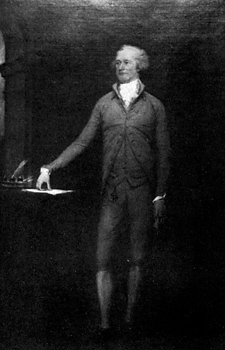The Federalist Party, the brainchild of Alexander Hamilton, was the first political party in American history. With the blessing of George Washington, it was the dominant force in the young American government until 1801. Hamilton, the first Secretary of the Treasury, believed in a strong federal government backed by a strong economic and banking system. First and foremost in that economic pillar was a Bank of the United States, which came into existence in 1791, with a 20-year charter. The newly formed United States had racked up tremendous debt during the Revolutionary War, and Hamilton successfully argued that the federal government should assume the states' debt and pay it off in bulk. Along with the idea of the Bank of the United States, Hamilton championed a federal mint, so that the federal government could print or imprint a common currency, which would have a standard value all over the country. A common complaint throughout the young history of the new country was that the shape, form, and value of currencies varied by state, which could lead to state-versus-state disputes over money that the Federalists thought would be fatal to the success of the country's economic success.
The Constitution didn't mention a Bank of the United States. Hamilton argued that the government's ability to set up a federal banking system was in the "implied powers" of the Constitution. He found support for this idea in the nation's businessmen and bankers but opposition from the nation's landowners and farmers, many of whom allied themselves with another new political party, the Democratic-Republicans. Led by Thomas Jefferson, the Democratic-Republicans opposed most if not all of the Federalists' agenda, most notably the federal banking system and the Jay Treaty. Another Federalist priority was an excise tax, which was paid by producers, not consumers. The Constitution directly gave the Government the power to collect taxes. Seeking to start the Government off on a firm footing, Hamilton recommended excise taxes on rum, sugar, tobacco, and whiskey. Only the last one proved unpopular, resulting in the Whiskey Rebellion, which Washington had to quell by calling up the militia. Washington himself didn't align himself with either of these political parties but warned against their influence in his farewell address. John Adams, the first Vice-president, was a Federalist, however, and succeeded Washington as President in 1796. Adams continued the Federalist banner for another four years, although he and Hamilton rarely found common ground. Foreign affairs dominated Adams's presidency. War was raging between France and Great Britain, Federalists preferred Britain and Democratic-Republicans preferred France. (In fact, one thing that most Americans agreed on at the time was the need to avoid another war, against any other country.) Still in control of the mechanisms of government, the Federalists passed the Alien and Sedition Acts, a pair of deeply controversial laws that gave the President the power to deport "dangerous" non-Americans (Aliens) and to make it a crime to publish false criticisms of the Government. The Federalists went further in their support of a strong federal government, creating a navy and expanding the army, and paying for it all with new taxes, on land and houses and slaves. Another rebellion ensued, this one called the Fries' Rebellion, but it wasn't as serious as the Whiskey Rebellion. The combination of the new taxes, the expanding federalism, and the Alien and Sedition Acts created a growing dislike of the Federalist agenda. The election of Jefferson as President in 1800 brought the Democratic-Republicans into power and marked the beginning of the end for the Federalists, in the legislature and the White House, anyway. The Democratic-Republicans gained control of Congress as well and cemented their reputation as a more national party, enjoying support up and down the Eastern Seaboard, unlike the Federalists, whose power base was mainly in New England. As the opposition party, the Federalists took great delight in pointing out the irony of the Louisiana Purchase, a Presidential initiative made by Jefferson, who had campaigned so vociferously on the need to curtail federal power. Another Federalist-like policy carried out by Jefferson was the Embargo Act of 1807, which placed an embargo on trade with Great Britain and resulted in a strong federal police presence enforcing the embargo. Hamilton died in 1804, the victim of a duelers' bullet fired by Aaron Burr. Without its guiding light, the Federalist Party limped along for a few more elections, nominating presidential candidates to run against a highly popular James Madison and James Monroe. Charles Cotesworth Pinckney won new England in 1808, but Madison won everything else, including the White House. Still in opposition (and still a friend of Great Britain), the Federalists opposed the War of 1812 and ran DeWitt Clinton as a peace candidate in the presidential election that year. Clinton fared no better than Pinckney four years earlier. In desperation four years later, the Federalists nominated Rufus King to take on James Monroe. King turned out to be the last Federalist candidate for President. He did not win. Carrying on the Federalist legacy, however, was John Marshall, the Chief Justice of the United States. An avowed Federalist, Marshall handed down a series of decisions in the infancy of the Supreme Court that solidified the primacy of the federal government, including Marbury v. Madison, McCulloch v. Maryland, and Gibbons v. Ogden. |
|
Social Studies for Kids
copyright 2002–2025
David White

 The federal banking system was also necessary, Hamilton argued, to establish credit with other countries, most notably Great Britain. Seeing the economic potential of a strong trade, the Federalists believed in good relations with Britain, as evidenced by the 1794
The federal banking system was also necessary, Hamilton argued, to establish credit with other countries, most notably Great Britain. Seeing the economic potential of a strong trade, the Federalists believed in good relations with Britain, as evidenced by the 1794 
